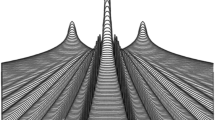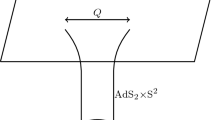Abstract
In this paper we discuss quantum computational restrictions on the types of thought experiments recently used by Almheiri, Marolf, Polchinski, and Sully to argue against the smoothness of black hole horizons. We argue that the quantum computations required to do these experiments would take a time which is exponential in the entropy of the black hole under study, and we show that for a wide variety of black holes this prevents the experiments from being done. We interpret our results as motivating a broader type of nonlocality than is usually considered in the context of black hole thought experiments, and claim that once this type of nonlocality is allowed there may be no need for firewalls. Our results do not threaten the unitarity of black hole evaporation or the ability of advanced civilizations to test it.
Similar content being viewed by others
References
A. Almheiri, D. Marolf, J. Polchinski and J. Sully, Black Holes: Complementarity or Firewalls?, JHEP 02 (2013) 062 [arXiv:1207.3123] [INSPIRE].
S.L. Braunstein, S. Pirandola and K. Zyczkowski, Entangled black holes as ciphers of hidden information, Physical Review Letters 110, 101301 (2013) [arXiv:0907.1190] [INSPIRE].
P. Hayden and J. Preskill, Black holes as mirrors: Quantum information in random subsystems, JHEP 09 (2007) 120 [arXiv:0708.4025] [INSPIRE].
S. Hawking, Breakdown of Predictability in Gravitational Collapse, Phys. Rev. D 14 (1976) 2460 [INSPIRE].
L. Susskind, L. Thorlacius and J. Uglum, The stretched horizon and black hole complementarity, Phys. Rev. D 48 (1993) 3743 [hep-th/9306069] [INSPIRE].
L. Susskind and L. Thorlacius, Gedanken experiments involving black holes, Phys. Rev. D 49 (1994) 966 [hep-th/9308100] [INSPIRE].
D.A. Lowe, J. Polchinski, L. Susskind, L. Thorlacius and J. Uglum, Black hole complementarity versus locality, Phys. Rev. D 52 (1995) 6997 [hep-th/9506138] [INSPIRE].
J. Polchinski, String theory and black hole complementarity, hep-th/9507094 [INSPIRE].
D. Harlow and L. Susskind, Crunches, Hats and a Conjecture, arXiv:1012.5302 [INSPIRE].
T. Banks and W. Fischler, An holographic cosmology, hep-th/0111142 [INSPIRE].
T. Banks, Holographic Space-Time: The Takeaway, arXiv:1109.2435 [INSPIRE].
T. Banks and W. Fischler, Holographic Space-Time Does Not Predict Firewalls, arXiv:1208.4757 [INSPIRE].
A.R. Brown, Tensile Strength and the Mining of Black Holes, arXiv:1207.3342 [INSPIRE].
R. Bousso, Complementarity Is Not Enough, arXiv:1207.5192 [INSPIRE].
D. Harlow, Complementarity, not Firewalls, arXiv:1207.6243.
K. Papadodimas and S. Raju, An Infalling Observer in AdS/CFT, arXiv:1211.6767 [INSPIRE].
T. Jacobson, Boundary unitarity without firewalls, arXiv:1212.6944 [INSPIRE].
L. Susskind, The Transfer of Entanglement: The Case for Firewalls, arXiv:1210.2098 [INSPIRE].
G.T. Horowitz and J.M. Maldacena, The black hole final state, JHEP 02 (2004) 008 [hep-th/0310281] [INSPIRE].
J. Preskill, P. Schwarz, A.D. Shapere, S. Trivedi and F. Wilczek, Limitations on the statistical description of black holes, Mod. Phys. Lett. A 6 (1991) 2353 [INSPIRE].
J.M. Maldacena, J. Michelson and A. Strominger, Anti-de Sitter fragmentation, JHEP 02 (1999) 011 [hep-th/9812073] [INSPIRE].
L. Dyson, M. Kleban and L. Susskind, Disturbing implications of a cosmological constant, JHEP 10 (2002) 011 [hep-th/0208013] [INSPIRE].
S. Aaronson, NP-complete problems and physical reality, Sigact News (2005) [quant-ph/0502072] [INSPIRE].
J.M. Maldacena, Eternal black holes in anti-de Sitter, JHEP 04 (2003) 021 [hep-th/0106112] [INSPIRE].
Y. Nomura, J. Varela and S.J. Weinberg, Complementarity Endures: No Firewall for an Infalling Observer, JHEP 03 (2013) 059 [arXiv:1207.6626] [INSPIRE].
S.D. Mathur and D. Turton, Comments on black holes I: The possibility of complementarity, arXiv:1208.2005 [INSPIRE].
I. Bena, A. Puhm and B. Vercnocke, Non-extremal Black Hole Microstates: Fuzzballs of Fire or Fuzzballs of Fuzz?, JHEP 12 (2012) 014 [arXiv:1208.3468] [INSPIRE].
A. Giveon and N. Itzhaki, String Theory Versus Black Hole Complementarity, JHEP 12 (2012) 094 [arXiv:1208.3930] [INSPIRE].
B.D. Chowdhury and A. Puhm, Is Alice burning or fuzzing?, arXiv:1208.2026 [INSPIRE].
S.G. Avery, B.D. Chowdhury and A. Puhm, Unitarity and fuzzball complementarity: ‘Alice fuzzes but may not even know it!’, arXiv:1210.6996 [INSPIRE].
S. Hossenfelder, Comment on the black hole firewall, arXiv:1210.5317 [INSPIRE].
D.-i. Hwang, B.-H. Lee and D.-h. Yeom, Is the firewall consistent?: Gedanken experiments on black hole complementarity and firewall proposal, JCAP 01 (2013) 005 [arXiv:1210.6733] [INSPIRE].
K. Larjo, D.A. Lowe and L. Thorlacius, Black holes without firewalls, arXiv:1211.4620 [INSPIRE].
D.N. Page, Hyper-Entropic Gravitational Fireballs (Grireballs) with Firewalls, JCAP 04 (2013) 037 [arXiv:1211.6734] [INSPIRE].
S.B. Giddings, Nonviolent nonlocality, arXiv:1211.7070 [INSPIRE].
D.N. Page, Average entropy of a subsystem, Phys. Rev. Lett. 71 (1993) 1291 [gr-qc/9305007] [INSPIRE].
S.D. Mathur, The information paradox: A pedagogical introduction, Class. Quant. Grav. 26 (2009) 224001 [arXiv:0909.1038] [INSPIRE].
E. Lieb and M. Ruskai, Proof of the strong subadditivity of quantum-mechanical entropy, J. Math. Phys. 14 (1973) 1938 [INSPIRE].
C.A. Fuchs, Distinguishability and accessible information in quantum theory, quant-ph/9601020 [INSPIRE].
P. Hayden, D. Leung, P. Shor and A. Winter, Randomizing quantum states: Constructions and applications, Commun. Math. Phys. 250 (2004) 371.
A. Kitaev, A. Shen and M.N. Vyalyi, Classical and Quantum Computation. Volume 47, American Mathematical Society, U.S.A. (2002).
J. Preskill, Lecture Notes on Quantum Computation, http://www.theory.caltech.edu/people/preskill/ph229/, (1998).
M. Nielsen and I. Chuang, Quantum Computation and Quantum Information, Cambridge University Press, (2010).
T. Banks, W. Fischler, S. Shenker and L. Susskind, M theory as a matrix model: A conjecture, Phys. Rev. D 55 (1997) 5112 [hep-th/9610043] [INSPIRE].
J.M. Maldacena, The large-N limit of superconformal field theories and supergravity, Adv. Theor. Math. Phys. 2 (1998) 231 [Int. J. Theor. Phys. 38 (1999) 1113] [hep-th/9711200] [INSPIRE].
E. Witten, Anti-de Sitter space and holography, Adv. Theor. Math. Phys. 2 (1998) 253 [hep-th/9802150] [INSPIRE].
R.P. Feynman, Simulating physics with computers, Int. J. Theor. Phys. 21 (1982) 467 [INSPIRE].
S. Lloyd et. al., Universal quantum simulators, Science 273 (1996) 1073.
D.S. Abrams and S. Lloyd, Simulation of many body Fermi systems on a universal quantum computer, Phys. Rev. Lett. 79 (1997) 2586 [quant-ph/9703054] [INSPIRE].
S.P. Jordan, K.S. Lee and J. Preskill, Quantum Algorithms for Quantum Field Theories, Science 336 (2012) 1130 [arXiv:1111.3633] [INSPIRE].
D. Kabat, G. Lifschytz and D.A. Lowe, Constructing local bulk observables in interacting AdS/CFT, Phys. Rev. D 83 (2011) 106009 [arXiv:1102.2910] [INSPIRE].
E. Verlinde and H. Verlinde, Black Hole Entanglement and Quantum Error Correction, arXiv:1211.6913 [INSPIRE].
P. Shor, Scheme for reducing decoherence in quantum computer memory, Phys. Rev. A 52 (1995) 2493.
K. Kraus, A. Böhm, J. Dollard and W. Wootters, States, effects, and operations fundamental notions of quantum theory, Lect. Notes Phys. 190 (1983).
C.H. Bennett, D.P. DiVincenzo, J.A. Smolin and W.K. Wootters, Mixed state entanglement and quantum error correction, Phys. Rev. A 54 (1996) 3824 [quant-ph/9604024] [INSPIRE].
E. Knill and R. Laflamme, Theory of quantum error-correcting codes, Phys. Rev. A 55 (1997) 900 [quant-ph/9604034] [INSPIRE].
D. Gottesman, Stabilizer codes and quantum error correction, quant-ph/9705052 [INSPIRE].
E. Berlekamp, R. McEliece and H. Van Tilborg, On the inherent intractability of certain coding problems (corresp.), IEEE Trans. Inf. Theory 24 (1978) 384.
M. Hsieh and F. Le Gall, Np-hardness of decoding quantum error-correction codes, Phys. Rev. A 83 (2011) 052331.
F. Denef and M.R. Douglas, Computational complexity of the landscape. I., Annals Phys. 322 (2007) 1096 [hep-th/0602072] [INSPIRE].
K.-Y. Kuo and C.-C. Lu, On the hardness of decoding quantum stabilizer codes under the depolarizing channel, in 2012 International Symposium on Information Theory and its Applications (ISITA) 2012, pg. 208-211.
C. Moore and S. Mertens, The Nature of Computation, Oxford University Press, Oxford U.K., (2011).
D.N. Page, Particle Emission Rates from a Black Hole: Massless Particles from an Uncharged, Nonrotating Hole, Phys. Rev. D 13 (1976) 198 [INSPIRE].
S. Goldwasser, S. Micali and C. Rackoff, The knowledge complexity of interactive proof systems, SIAM J. Comput. 18 (1989) 186.
J. Watrous, Limits on the power of quantum statistical zero-knowledge, in proceedings of The 43rd Annual IEEE Symposium on Foundations of Computer Science (FOCS), 2002, pg. 459-468.
J. Watrous, Zero-knowledge against quantum attacks, SIAM J. Comput. 39 (2009) 25.
P. Hayden and B. Swingle, Quantum error correction and QSZK, in preparation.
P. Hayden, K. Milner and M.M. Wilde, Two-message quantum interactive proofs and the quantum separability problem, arXiv:1211.6120.
B. Schumacher, Quantum coding, Phys. Rev. A 51 (1995) 2738.
A.Y. Kitaev, Quantum measurements and the Abelian stabilizer problem, quant-ph/9511026 [INSPIRE].
D. Bacon, A. Childs and W. Van Dam, From optimal measurement to efficient quantum algorithms for the hidden subgroup problem over semidirect product groups, in FOCS 2005 - 46th Annual IEEE Symposium on Foundations of Computer Science, 2005, pg. 469-478.
G. Kuperberg, A subexponential-time quantum algorithm for the dihedral hidden subgroup problem, SIAM J. Comput. 35 (2005) 170.
G. Ivanyos, L. Sanselme and M. Santha, An efficient quantum algorithm for the hidden subgroup problem in nil-2 groups, LATIN 2008: Theoretical Informatics (2008) 759.
M. Ettinger and P. Hoyer, A quantum observable for the graph isomorphism problem, quant-ph/9901029 [INSPIRE].
C. Moore, A. Russell and L. Schulman, The symmetric group defies strong fourier sampling, SIAM J. Comput. 37 (2008) 1842.
C. Moore, A. Russell and P. Sniady, On the impossibility of a quantum sieve algorithm for graph isomorphism, SIAM J. Comput. 39 (2010) 2377.
C. Moore, A. Russell and U. Vazirani, A classical one-way function to confound quantum adversaries, quant-ph/0701115.
S. Aaronson, Quantum lower bound for the collision problem, in proceedings of The thirty-fourth annual ACM symposium on Theory of computing, 2002, pg. 635-642.
L. Fidkowski, V. Hubeny, M. Kleban and S. Shenker, The black hole singularity in AdS/CFT, JHEP 02 (2004) 014 [hep-th/0306170] [INSPIRE].
G. Horowitz, A. Lawrence and E. Silverstein, Insightful D-branes, JHEP 07 (2009) 057 [arXiv:0904.3922] [INSPIRE].
D.N. Page, Thermodynamics of near extreme black holes, hep-th/0012020 [INSPIRE].
S.P. Kim and D.N. Page, Magnetic black holes are also unstable, J. Korean Phys. Soc. 45 (2004) S59 [gr-qc/0403005] [INSPIRE].
G.T. Horowitz and A. Strominger, Black strings and P-branes, Nucl. Phys. B 360 (1991) 197 [INSPIRE].
S. Gubser, I.R. Klebanov and A. Peet, Entropy and temperature of black 3-branes, Phys. Rev. D 54 (1996) 3915 [hep-th/9602135] [INSPIRE].
R.L. Arnowitt, S. Deser and C.W. Misner, Coordinate invariance and energy expressions in general relativity, Phys. Rev. 122 (1961) 997 [INSPIRE].
S. Hawking and D.N. Page, Thermodynamics of Black Holes in anti-de Sitter Space, Commun. Math. Phys. 87 (1983) 577 [INSPIRE].
E. Witten, Anti-de Sitter space, thermal phase transition and confinement in gauge theories, Adv. Theor. Math. Phys. 2 (1998) 505 [hep-th/9803131] [INSPIRE].
T. Nishioka, S. Ryu and T. Takayanagi, Holographic Superconductor/Insulator Transition at Zero Temperature, JHEP 03 (2010) 131 [arXiv:0911.0962] [INSPIRE].
D. Anninos, F. Denef and D. Harlow, The Wave Function of Vasiliev’s Universe - A Few Slices Thereof, arXiv:1207.5517 [INSPIRE].
S.R. Das, G.W. Gibbons and S.D. Mathur, Universality of low-energy absorption cross-sections for black holes, Phys. Rev. Lett. 78 (1997) 417 [hep-th/9609052] [INSPIRE].
I.R. Klebanov, World volume approach to absorption by nondilatonic branes, Nucl. Phys. B 496 (1997) 231 [hep-th/9702076] [INSPIRE].
S. Hawking, Particle Creation by Black Holes, Commun. Math. Phys. 43 (1975) 199 [Erratum ibid. 46 (1976) 206-206] [INSPIRE].
S.S. Gubser and I.R. Klebanov, Absorption by branes and Schwinger terms in the world volume theory, Phys. Lett. B 413 (1997) 41 [hep-th/9708005] [INSPIRE].
L. Susskind, Black Hole Complementarity and the Harlow-Hayden Conjecture, arXiv:1301.4505 [INSPIRE].
S. Gubser, I.R. Klebanov and A.M. Polyakov, Gauge theory correlators from noncritical string theory, Phys. Lett. B 428 (1998) 105 [hep-th/9802109] [INSPIRE].
C.G. Callan and J.M. Maldacena, Brane death and dynamics from the Born-Infeld action, Nucl. Phys. B 513 (1998) 198 [hep-th/9708147] [INSPIRE].
K.G. Savvidy and G.K. Savvidy, Neumann boundary conditions from Born-Infeld dynamics, Nucl. Phys. B 561 (1999) 117 [hep-th/9902023] [INSPIRE].
Author information
Authors and Affiliations
Corresponding author
Additional information
Dedicated to John Preskill on the occasion of his 60th birthday
ArXiv ePrint: 1301.4504
Rights and permissions
About this article
Cite this article
Harlow, D., Hayden, P. Quantum computation vs. firewalls. J. High Energ. Phys. 2013, 85 (2013). https://doi.org/10.1007/JHEP06(2013)085
Received:
Accepted:
Published:
DOI: https://doi.org/10.1007/JHEP06(2013)085




